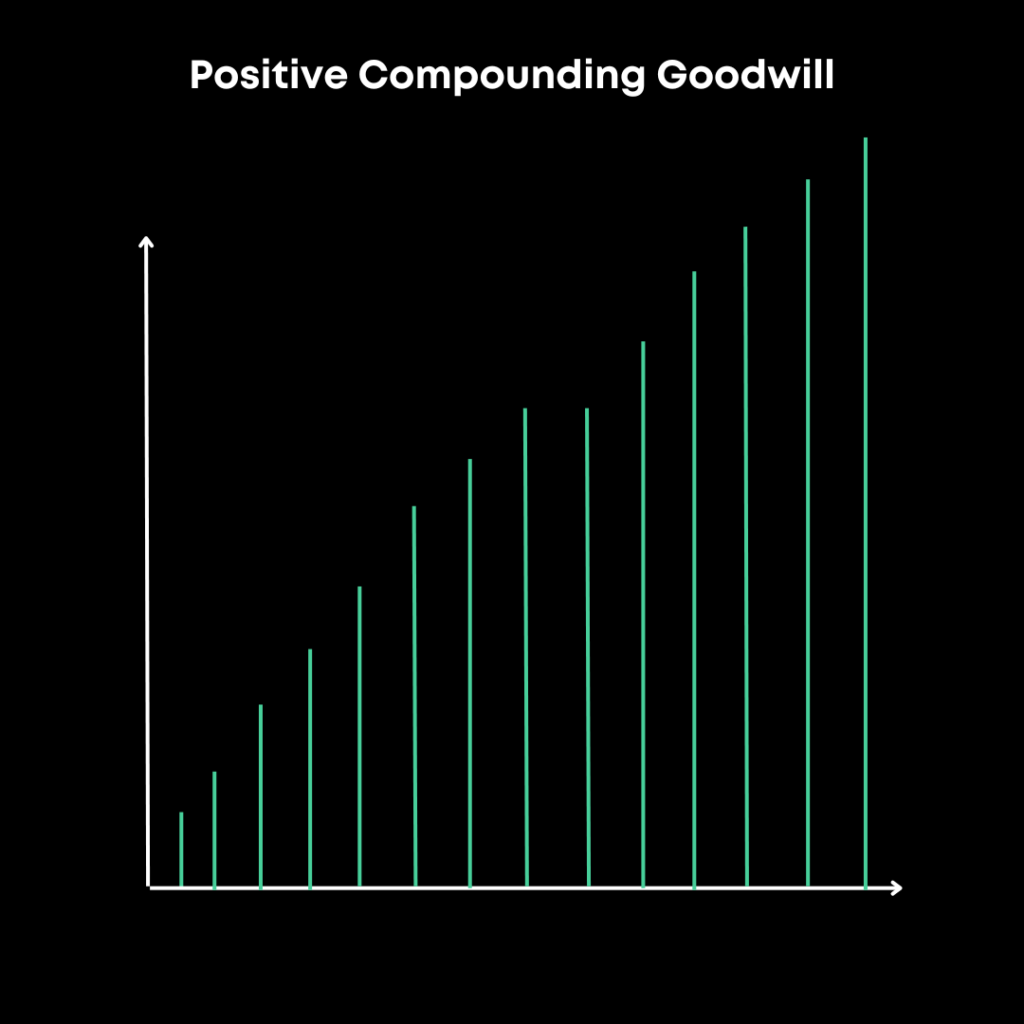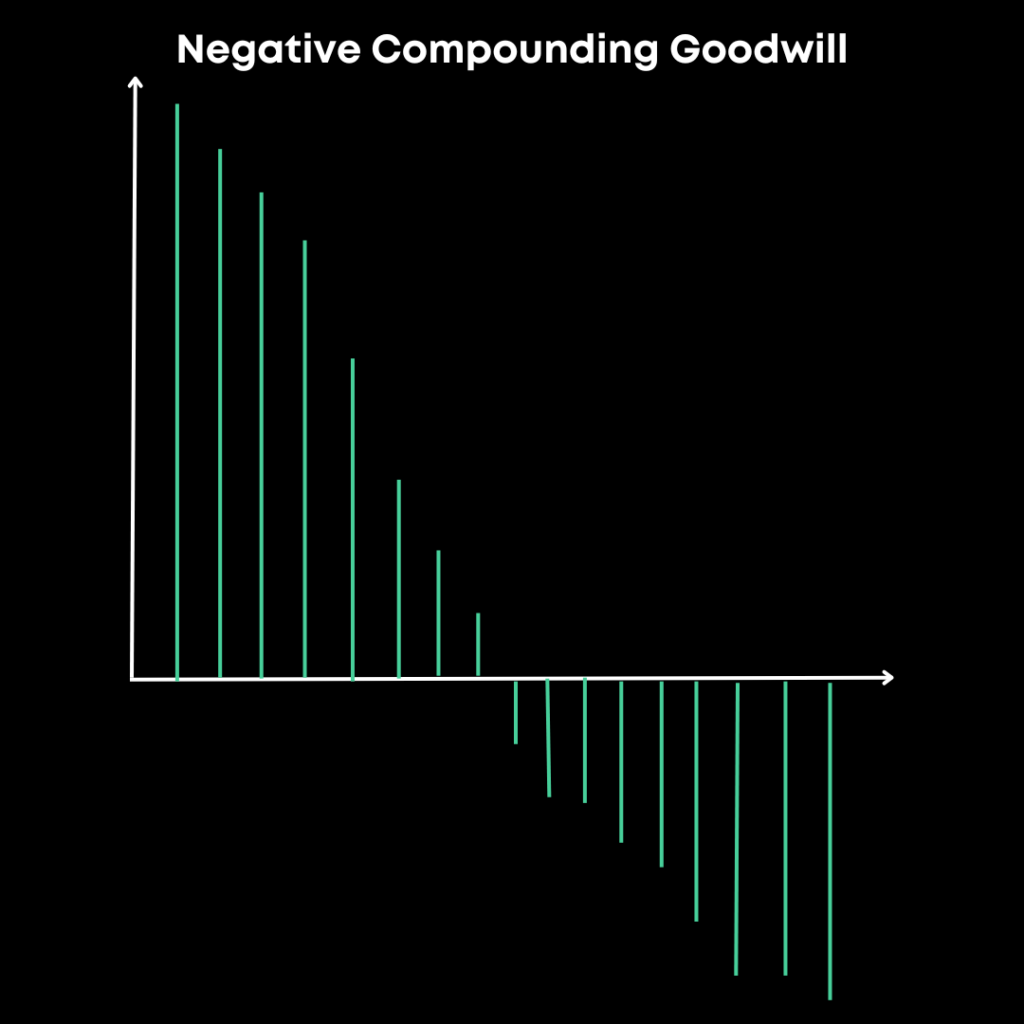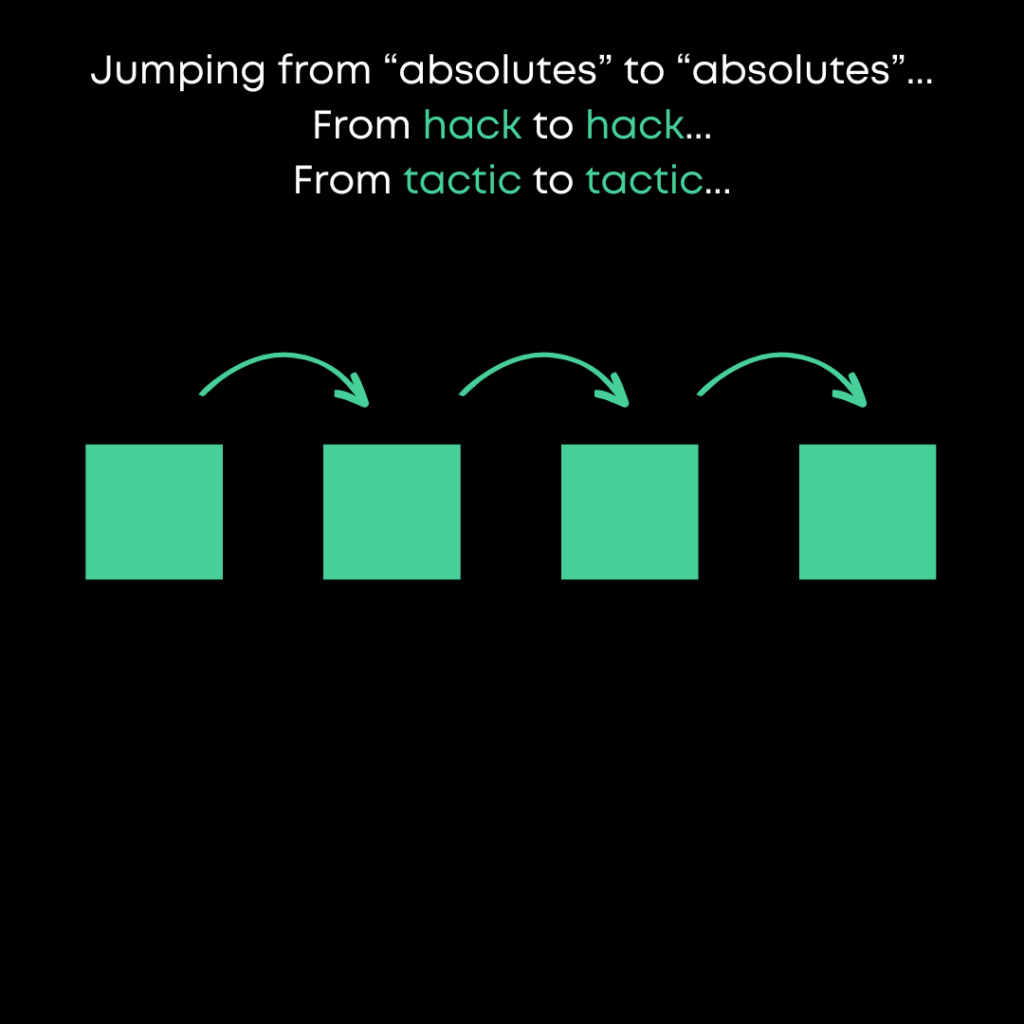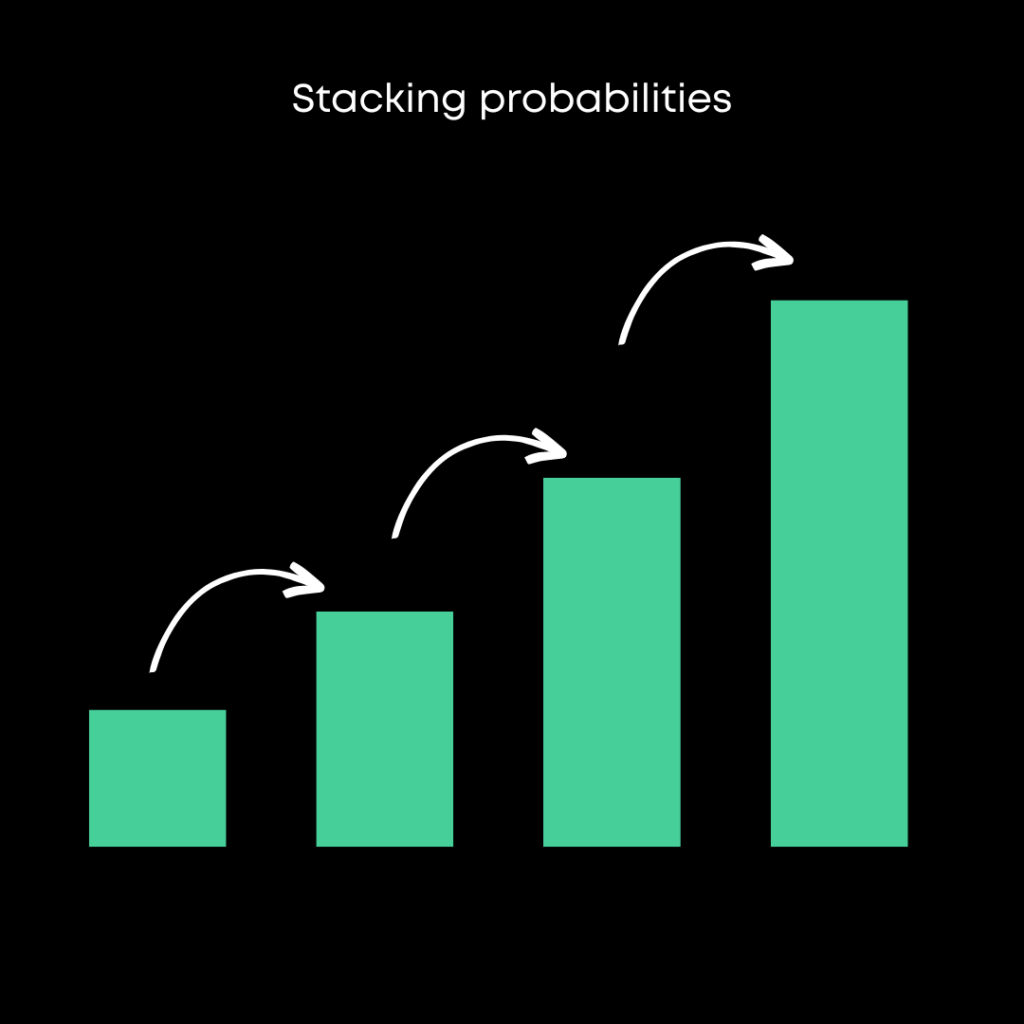Hey, it’s Max,
Welcome to our Ecosystem Business Manifesto.
We all face the same problem: how to make our brand and offer known (awareness) to our ideal customers.
The challenge of having our product or service spread to people who care is a necessary part of our journey.
We want to build a brand that matters to the right people… our ideal customers… our tribe.
Whether you’re a DTC brand, SaaS company, or solopreneur, how you make yourself known, liked, and trusted by them matters… a lot.
In a world where bigger and bigger claims have spread in every single industry, we don’t believe the ”too good to be true offer’’ form of marketing is the go-to way to serve customers from now on…
Long term, companies who decide to keep operating from that ‘push’ mindset will likely hurt their brand.
It doesn’t have to be this way…
It all begins with our ‘marketing mindset’.
Why?
Mindsets will dictate the strategies we follow, which will dictate the tactics we apply.
If the mindset you’re operating from is ‘wrong’, everything downstream will be more difficult. With the right mindset, you’re sailing with the wind behind you… and everything you do is easier.
But what do we mean by ‘’mindset’?
Mindset is simply the lens through which you see the world.
Everything you believe to be true or false, your desires and deepest fears all worked together to craft the way you see life. Your mindset.
And when you apply the wrong mindset upstream to the game you’re playing, you’re setting yourself up for hardships downstream.
So how can we apply this to marketing?
We must not compete with anyone else but ourselves.
There are no better metrics than getting better day after day, year after year, relative to where we started.
- Developing better relationships with ideal customers
- Creating better products
- Delivering a better customer experience
What can you improve today that would matter most to your customers?
When operating from this mindset we focus on what we can control (getting better) rather than on what we can’t (our competition).
And since there is no ‘finish line’ in business as it’s an infinite game, we have all the time we need to develop strategies and systems that will produce long-term happy customers (we’ll cover this more later).
That doesn’t mean it’ll be perfect today. But it can be better today than it was yesterday.
- How will your business be better next week?
- Next month?
- Next year?
What decisions can you make today to develop better relationships with your customers and deliver them a better experience so they can become raving fans (your flywheel)?
For example, maybe that ‘persuasion’ hack you watched yesterday will get you more sales this week. Or that it will convert more traffic into leads and into customers…
But, at what cost?
What are the long-term consequences to the relationships between you and your ideal customers when you’re relying on hacks?
Focus on building better relationships with your customers, on developing better products, and on delivering better customer experience…
And leave the rest to the finite players.
The goal is to keep on playing, on getting better, and on making everyone win. There’s no finish line.
Next up: create customers before money changes hands. When you see the world through that lens, everything changes.
The red herring is to believe that we need to push for a sale as fast as possible.
Not true.
We’ll unpack this next…
Create Happy Customers Before Money Changes Hands
So the previous section was about the importance of your marketing mindset.
Now, let’s make a complete shift in worldview, from what we want to what our customers want, and let’s see how this shift will transform your business.
As entrepreneurs, service providers, and business owners it is easy to focus and optimize for our own goals, dreams, and needs.
- “ I want to achieve…”
- “My business will bring pay me $….”
- “My goal for the quarter is …”
But something almost magical happens when we ditch our selfish lens and focus on the goals, dreams, and needs of the audience we serve, aka our ideal customers.
- “How can I deliver a better customer experience?”
- “What problems do my customers need to be solved?”
- “What do my audience care about?”
From this perspective, the monetary reward we get is simply a by-product of delivering massive value to our customers as opposed to it being the driving force behind our actions.
“Money is just a consequence. I always say to my team, ‘Don’t worry too much about profitability. If you do your job well, the profitability will come. ‘ – Bernard Arnault, Chairman & CEO of LVMH”
The value we give is the cause.
The money we receive in return is the consequence.
Reread that again.
The first step is for us to fully understand the needs of our customers and how can we help them.
As Rich Shefrein says “the market is made of frustrated buyers”. They have needs to be met and desires to be achieved, and they haven’t found anything yet to help them.
So by fully feeling our customers’ frustrations we can help channel the desire for the outcome they want through our product or service.
One simple way to better understand what our customers value the most in our product or service is simply to interview them, and get feedback with surveys (IG or email list).
By doing these activities we’ll begin to accumulate insights about our audience.
The next step will then be to act on these insights… as reading them only simply won’t cut it.
One cool story about that is from Alex Hormozi’s book $100M Offer where he shared how he took a company in the photography space from an AOV of $300 to $1,500, and how he 38x’d the profit of the business in just two years.
Even cooler, the company now spends less time per customer and has higher customer satisfaction.
“But none of that would have been possible without figuring out what people valued most, tripling down on it, and ruthlessly eliminating everything else.” – Alex Hormozi, CEO of Acquisition.com
And when you’re ready, there are three non-negotiable decisions to make based on the Strategy of Preeminence of Jay Abraham.
- Treat everyone like a client… even if money has yet to change hands.
- Explicitly connect the dots for your clients and show them a better way.
- Realize that you’re doing your clients a disservice by not making sure they’re getting 100% of the value of your offer.
When we adopt these worldviews and act on them, we operate from an infinite lens as we recognize that the decisions we’re making will compound positively for us and our clients.
Interesting dynamics will start revealing themselves.
As our ideal customers realize, consciously or unconsciously, that we serve first (cause), before money ever changes hands, attention (consequence) is earned, then trust follows.
Our prospects will experience a kind of ‘gravitational pull’ in our direction.
These are the results you get when you play the long game. The infinite game.
(Btw, even an opt-in could be seen as a form of transaction as we’re asking someone to give us not money, but something arguable just as precious, aka their attention.)
In this Manifesto, we’ve unpacked a few key insights so far…
When we decide to develop meaningful relationships with the people who have chosen to follow us or subscribe to our email/SMS lists (give us their attention), everything becomes almost effortless.
And when we align our mindset and behavior with our ideal clients’ desires.
… We basically have created customers before money ever changes hands.
By changing our mindset and behavior (serving first), our best prospects will start seeing themselves as customers before they’re presented with an opportunity to buy our offer.
Some companies rely on making bigger and bigger claims and persuasion hacks to push for each sale.
While some use none of these…
The “persuasion” tools and hacks are concepts foreign to them.
Finite thinkers are left wondering how they sell anything at such a scale. Until you get to experience their brand through a prospect’s POV, everything starts to make sense.
Take some time to re-read this section another time.
It’s filled with insights for you to harvest.
Ecosystem Business Strategy
Now, we’re going to switch the concept of ‘marketing funnels’ upside down and present an alternative directly inspired by ecosystem strategy.
The common way people approach marketing is from a linear thinking point of view where A leads to B which leads to C.
Where one cause has one effect. In our experience and probably yours too, we have found that this is rarely the case.
When you see the world through the ‘ecosystem’ lens you can clearly see that everything affects everything… and sometimes in unexpected and mysterious ways.
A butterfly effect if you will.
This section is filled with insights engineered to reframe how you look at what you do in regard to marketing.
Once you grasp it, you’ll never be able to see business in the same way.
Many people believe that the only way to succeed in business is to have a ‘funnel’ that can be optimized one part at a time.
Traffic > Opt In > Sales Page > Upsell
And when their ‘funnel’ doesn’t work, they try to optimize one part at a time and then hope this ‘fixes’ it.
- If Cost-Per-Click is low, but the conversion is low, maybe the sales page needs to be fixed…
- Or maybe the traffic targeting isn’t quite right…
- Or maybe we should add a countdown timer on the sales page to add urgency…
They are basically gaming their way to get more sales as quickly as a lead enters their ‘funnel.
By doing so, yes they might have more sales short term… but at what cost?
They only see the first-order consequence (immediate sales) and never think about the second, let alone the third-order consequence (long-term success) of their decisions and actions.
Legendary marketer Dean Jackson has analyzed his clients’ data and realized that 85% of leads who eventually buy do so after 90 days…
So let’s imagine you were able to ‘optimize’ each part of your funnel and were able to generate 150 sales in the first few weeks. Is this a ‘win’?
We don’t know…
These 150 first sales are just the tip of the iceberg. If Dean’s results are correct, there are another 850 potential customers ALREADY ON YOUR LIST who will buy sometime after 90 days (if you don’t convince them otherwise during that time).
Now that you know that the first few sales are only a tiny fraction of the total sales you’ll make because of your effort, will you keep communicating with your audience as before? Or are you going to approach this old thing differently?
The problem isn’t the tactics.
The problem is linear thinking. Where A leads to B which leads to C.
And by focusing on a linear one-size-fits-all approach with a ‘funnel’ we likely undermine long-term sales (85%) for the short-term sales (the first 15%).
As we’ve covered before, when we change our thinking upstream, everything gets easier and better downstream.
Your business is not a ‘funnel’ or parts assembled together that can be optimized.
Why?
Because behind every metric and KPIs… behind the numbers… guess what you’ll find?
People…Just like you and I.
Your business is an ecosystem from which results sprout from the infinite interactions of the parts.
Re-read it again. Let that sink in…
Each part can be optimized, yes. But this will only matter if the optimization takes into account the interactions between the other parts of your business ecosystem.
For example…
Let’s take the THREE essential elements of any successful business system:
- Awareness (traffic)
- Engagement (leads)
- Conversion (sales)
These elements all interact with each other in ways in which meaningful results sprout.
If we want to get the ‘Compounding Goodwill’ that Hormozi talks about in this video.

Similar to what Apple, Tesla, and Nike have created, then we need to optimize our business to produce ‘happy customers’.
‘Happy customers’ are simply the EXACT OPPOSITE of Bad Clients:
- They don’t refund
- They use the product
- They buy more and often
- They love the customer experience
- They rave about your brand and products to everyone
What all ‘happy customers’ have in common is the FEELING they get from using and interacting with a product or service.
Think about how customers of Tesla’s cars are vastly different from Ford’s or GM’s…
People have to get on a waiting list to get a Tesla and they’re raving about it with their friends on social… Think about that!
Have you ever seen someone do that with Ford, GM, or even Toyota?
No. This is also why Tesla is worth 2x more than those…combined!
A cool side effect of optimizing for happy customers is that your marketing will compound on goodwill and word-of-mouth… Making your CAC shrinks and your LTV skyrockets.
That is how Tesla is worth 10x more than Volkswagen while only spending 1% of VW’s $6.6 billion marketing budget.

In the end, yes the product is important, but that is not what makes a happy customer. It is the feeling they experience when they interact with and use your product or service.
Having the latest iPhone does nothing on its own. Taking amazing photos with it and sharing them with your friends on social so they can engage with you, contribute to this feeling of BEING a happy customer.
I know feelings can’t be measured and put on a spreadsheet, and that’s why most businesses focus on less meaningful stuff like # of followers, # of new email subs, # clicks on paid ads, etc.
But these numbers can’t paint the whole painting… as they don’t take into consideration the infinite interactions of all the parts of your business ecosystem.
A good start would be to simply ask this question:
“ If I were to become a customer of my own product, would this tactic move me closer or further away from becoming a happy customer?”
Walk into your prospects’ shoes; does the aggressive copy, almost too good to be true claims, or the fake scarcity pull you to become a happy customer, or do they push you away?

Always keep that in mind.
Remember, only 15% of your total sales will come in the first 90 days.
The remaining 85% of customers have opted for a Choose Your Own Adventure type of ‘funnel’ where A might lead to F which leads to Z and then leads to D.
It is their choice. Your job is simply to make their journey, whichever they choose to follow, as pleasant and valuable as needs be.
They’ll consume your content and remain prospects until they feel ready to become happy customers.
They’ll keep on reading your emails and watching your YT videos and IG Stories. Slowly but surely, they’ll begin to feel a pull toward your brand as they begin to realize that your product or service is the gateway they’ve been looking for in order to reach the outcome they want.
Simple. Easy. Effective.
Thinking in Probabilities
Now, this section is about how to stack probabilities in our favor for better long-term success in your business.
Probabilities vs. absolutes
Most people are playing this business game with a finite thinking lens and always try to find the ‘best’ way or the new ‘hack’ to get results.
- Billionaire morning routine…
- Biohacking supplement stacks…
- Quiz funnels…
- ‘Perfect’ webinar funnels…
- Making bigger claims…
- And on and on the list goes…
The problem is not that these tactics don’t work. They are simply NOT the reason why an offer succeeds.
The problem is the ‘magic pill’ mindset that tricks people into believing that if they just follow the ‘right’ blueprint or swipe this or that template then they’ll get the same results as their ‘guru’ selling the course.

The thing is there is no cause-and-effect relationship between any specific methodology and success.
Through time, everything changes.
Competition increases.
Customers get wiser.
Markets change and evolve.
- The SEO tactics of 2014 simply don’t work anymore…
- The Facebook Ads that were printing in 2016… would fail in 2023 and beyond…
- The fake scarcity to sell courses on Twitter and IG like it’s still 2021 also doesn’t make the cut anymore… (Does anybody else remember the infamous “One Left” on their timeline ?)
A good rule of thumb is that by the time a course launches out about the latest hack, tool, or tactic… it is probably too late to experience the same success following it as the guru selling this ‘magic pill’ had.
It’s an example of something called the ‘survivorship bias’.
When you ONLY look at people who’ve survived (aka succeeded) to determine if something works… It’s called survivorship bias.
One of the best examples that we see almost weekly on social media or on MSM is the morning routine of successful people like billionaires, athletes, movie stars, etc.
- It’s not because Warren Buffett drinks 12 Coca-Cola per day that he’s a billionaire…
- It’s not because Alex Becker takes 60 supplement pills every morning and does red-light therapy that he was able to make $100s of millions…
- And it’s not because Alex Hormozi eats icecream every evening that he’s so buff and successful…
I know it’s a bummer.
But the vast majority of Coca-Cola drinkers, biohackers, and icecream enthusiasts aren’t also billionaires or successful.
To overcome these problems we have to stop thinking in absolutes, and instead, start thinking in probabilities.
Instead of looking for the latest hack or tactic (because they always change through time)…
We have to look for what WON’T change in the future.
We can choose principles that we believe can contribute to our success long term.
For examples:
- Provide value first before a transaction happens
- Develop better relationships with your ideal clients
- Create better and more believable offers
Do we believe these principles will be responsible for our success?
Maybe not responsible… but contributing factors for sure.
Similar to adopting the right mindsets… the right principles make everything down the line better and easier.
We believe that giving value in advance, before money changes hands, will increase the probability of our success…
We believe that developing more meaningful relationships with people who gave us their attention will increase the probability of our success…

We believe that developing better offers…
- Helping our ideal customers achieve their dream outcome…
- Increasing their perceived likelihood of achievement…
- Decreasing their effort and sacrifice…
- Shortening the time delay…
…will increase the probability of our success.
You can stack the deck in your favor in every aspect of your business (awareness, engagement, and conversion).
For example, there’s nothing to buy in this series. I’m writing it because I hope you get value from it.
What’s the equivalent for your business?
How can you increase your probability of success?
There are no ‘magic pills’ that guarantee success.
Real success comes from doing the boring work, day in and day out. It’s chopping wood. It’s doing the reps. Every. Single. Day.
These actions based on sound principles will stack the odds of success in your favor.
Over time, the impact of these ‘reps’ will compound, and success will simply become a by-product of you doing the ‘boring’ work. It’s inevitable.
Next…
Now, let’s recap what we’ve covered so far in this series, and then we’ll see how this all fits into the bigger picture.
Then, I’ll share some resources that will allow you to Choose Your Own Adventure in regards to your business journey.
As we’ve seen in the first section, marketing, and business are infinite games. The goal is to keep on playing and getting better at it. There is no end.
It’s a Never Ending Story.
Just like in every Epic Journey story, a Hero encounters a problem along his or her journey.
Who should they listen to? What path should they take?
As we unpacked a bit later on, there are no ‘magic pills’ or ‘magic artifacts’ that can guarantee our hero’s journey success.
There are only sound principles one could follow in order to stack the odds of success in one’s favor.
As business owners, we could ask ourselves “How can we double our revenue in the next 12 months?”
But as Bernard Arnault, CEO of luxury brands conglomerate LVMH, taught us:
“ Money is just a consequence.
I always say to my team, ‘Don’t worry too much about profitability.
If you do your job well, the profitability will come.”
We must create customers before money ever changes hands.
We have to go from a revenue-first mentality to a service-first one…
Money is just a cool side-effect of optimizing your business ecosystem for happy customers.
And if following that ‘principle’ works for the $80-Billion-A-Year Louis-Vuitton Moët-Hennessy conglomerate, it should certainly help us stack some odds of success in our favor, right?
We are on this infinite business journey together.
There will be hard times. There will be obstacles.
Nobody is smart enough to avoid them all. Fortunately for us, we don’t have to.
Obstacles are simply stepping stones for us to learn, grow, and get better (infinite thinking) so we can reach the next level of this beautiful game called Life.
I hope this short series gave you some new lens through which to see the work you do…
So you can leverage your new worldviews to get on the path you really want to follow.
Our journey together doesn’t have to stop right now if you wish it not.
From now on, you’ll start to receive our Growthy Leads Newsletter regularly where we’ll share insights, stories, and case studies that we believe can be of value to you.
Thank you so much for your attention. I truly appreciate it.
We’re looking forward to continuing to serve you.
Max
P.S.
If at any point you want out, there is an unsub button in the footer of every email. Clicking it will delete you from our email system.
